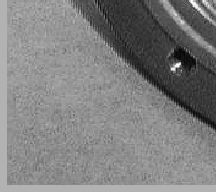
|

|
Assume for a moment that the horn would be placed at the Cassegrain focus of the antenna. Good matching would be difficult to achieve because the field amplitude from a point source (Airy pattern) exhibits radial oscillations alternating between positive and negative values, and has a scalesize proportional to wavelength.
These problems are avoided by coupling --via suitable relay optics-- the horn to an image of the aperture. This fulfills the condition of frequency-independent illumination. In other words, imagine that we propagate the horn mode back to the antenna aperture as if we were dealing with a transmitter, then the illumination pattern is independent of frequency. Using suitably designed corrugations on the inner wall of the horn (see fig. 5.3) the TE10 mode of the rectangular waveguide couples to a mode at the aperture of the horn whose amplitude has circular symmetry, and whose polarization is pure linear.